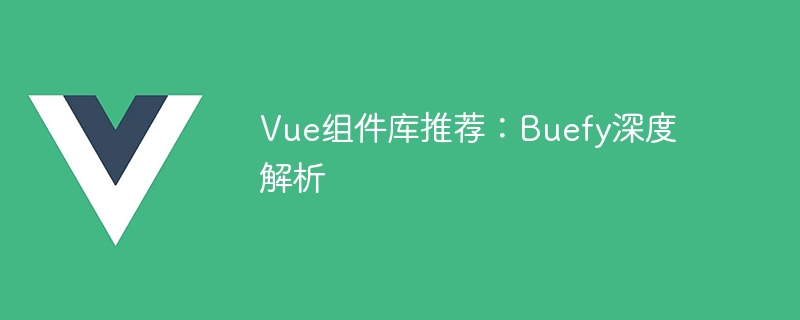Vue组件库推荐:Buefy深度解析
- 王林原创
- 2023-11-24 09:11:111365浏览

Buefy是基于Vue.js和Bulma CSS的开源UI组件库,用于快速构建漂亮且易于维护的Web应用程序。由于Vue.js的生命周期和组件化的特性,Buefy能够提供一些层级明确的组件,以便用户更清晰地组织和使用他们的代码。
Buefy已经自带了很多功能丰富的组件,其中包括表单、标签栏、模态框、滑块、日期选择器、轮播、进度条、对话框和菜单等组件,以及一些辅助工具和插件。
在这篇文章中,我们将深入探讨Buefy的主要组件和其使用方法,并提供可操作的代码示例来帮助您更深入地认识这个有用的组件库。
安装
在开始使用Buefy之前,需要在您的Vue.js应用程序中安装它。您可以通过npm包管理器安装它,如下所示:
npm install buefy
当您成功安装Buefy后,您需要在Vue.js应用程序中引入它。您可以直接在Vue.js组件中引入它,或者在全局Vue.js实例中引入它以使其在整个应用程序中可用。下面是在Vue.js组件中引用Buefy的示例代码:
<template>
<div>
<b-button>Click me</b-button>
</div>
</template>
<script>
import Buefy from 'buefy';
import Vue from 'vue';
Vue.use(Buefy);
</script>此处,我们使用Buefy创建了一个简单的按钮组件,并通过Vue.use()方法在Vue.js实例中引用了它。
使用
现在您已经安装了Buefy并成功引用了它,让我们来深入了解一下它的主要组件和其使用方法。
表单
Buefy中的表单组件非常强大,包括输入、选择、复选框、单选按钮和开关等组件。下面是一个使用Buefy的基本表单示例:
<template>
<div>
<b-field label="Username">
<b-input placeholder="Enter your username"></b-input>
</b-field>
<b-field label="Password">
<b-input type="password" placeholder="Enter your password"></b-input>
</b-field>
<b-field label="Gender">
<b-radio-group>
<b-radio name="gender">Male</b-radio>
<b-radio name="gender">Female</b-radio>
</b-radio-group>
</b-field>
<b-field label="Favorite Colors">
<b-checkbox-group>
<b-checkbox name="color">Red</b-checkbox>
<b-checkbox name="color">Green</b-checkbox>
<b-checkbox name="color">Blue</b-checkbox>
</b-checkbox-group>
</b-field>
<b-field>
<b-switch></b-switch>
<span>Remember me?</span>
</b-field>
<b-field>
<b-button type="is-primary">Submit</b-button>
</b-field>
</div>
</template>
<script>
import { BField, BInput, BRadioGroup, BRadio, BCheckboxGroup, BCheckbox, BSwitch, BButton } from 'buefy';
export default {
components: {
BField,
BInput,
BRadioGroup,
BRadio,
BCheckboxGroup,
BCheckbox,
BSwitch,
BButton,
},
};
</script>这个表单包括输入、密码、单选和多选框、开关和提交按钮等组件。每个组件都包含在Buefy的表单域中,以帮助我们更轻松地创建和管理表单输入。
标签栏
标签栏是一个常见的UI元素,可用于将页面内容分组或将导航链接组合在一起。Buefy中的标签栏非常易于使用,只需要添加适当的标签即可。下面是一个使用Buefy的基本标签栏示例:
<template>
<div>
<b-tabs>
<b-tab-item label="Home">
Welcome to the homepage
</b-tab-item>
<b-tab-item label="Profile">
Here is your profile information
</b-tab-item>
<b-tab-item label="Messages">
You have 15 new messages
</b-tab-item>
</b-tabs>
</div>
</template>
<script>
import { BTabs, BTabItem } from 'buefy';
export default {
components: {
BTabs,
BTabItem,
},
};
</script>这个标签栏含有三个标签,标题分别为“Home”、“Profile”和“Messages”。每个标签具有相应的内容,这些内容将根据所选的标签进行显示。
模态框
模态框可用于显示一些提示、确认信息或突出显示某些内容。Buefy中的模态框非常灵活且可自定义,以满足不同的需求。下面是一个使用Buefy的基本模态框示例:
<template>
<div>
<b-button @click="showModal = true">Show Modal</b-button>
<b-modal :active.sync="showModal">
<p>Are you sure you want to delete this item?</p>
<b-button type="is-danger" @click="deleteItem">Yes, delete it</b-button>
<b-button @click="showModal = false">Cancel</b-button>
</b-modal>
</div>
</template>
<script>
import { BButton, BModal } from 'buefy';
export default {
components: {
BButton,
BModal,
},
data() {
return {
showModal: false,
};
},
methods: {
deleteItem() {
console.log('Item deleted!');
this.showModal = false;
},
},
};
</script>这个模态框包含一个“Show Modal”按钮,在单击后将显示模态框。模态框中包含有一些文本,以及一个“Yes, delete it”按钮和一个“Cancel”按钮。当用户单击“Yes, delete it”按钮时,将执行deleteItem()方法并关闭模态框。
滑块
如果您需要在应用程序中调整数值,那么滑块将是一个有用的UI组件。Buefy中的滑块提供了多个选项和自定义事件,以便您可以使用滑块表单控制器。下面是一个使用Buefy的基本滑块示例:
<template>
<div>
<b-slider v-model="sliderValue" min="0" max="100"></b-slider>
<p>{{ sliderValue }}</p>
</div>
</template>
<script>
import { BSlider } from 'buefy';
export default {
components: {
BSlider,
},
data() {
return {
sliderValue: 50,
};
},
};
</script>这个滑块允许用户调整值的范围是0到100之间,滑块的位置将根据用户的拖动而移动,且将在下方显示当前选择的值。
日期选择器
如果您需要让用户选择日期或日期范围,则日期选择器将是一个非常有用的UI组件。Buefy中的日期选择器包括单选、范围和日历视图,以及自定义目录和周起始日等选项。下面是一个使用Buefy的基本日期选择器示例:
<template>
<div>
<b-datepicker v-model="selectedDate"></b-datepicker>
<p>Date selected: {{ selectedDate }}</p>
</div>
</template>
<script>
import { BDatepicker } from 'buefy';
export default {
components: {
BDatepicker,
},
data() {
return {
selectedDate: null,
};
},
};
</script>这个日期选择器允许用户选择一个日期,选定的日期将在下方显示。
进度条
进度条可用于在应用程序中显示操作的进度或状态。Buefy中的进度条具有多种样式和自定义选项,以帮助您更好地控制其外观和行为。以下是使用Buefy的基本进度条示例:
<template>
<div>
<b-progress :value="progressValue" :max="maxValue" type="is-primary"></b-progress>
<p>Progress: {{ progressValue }}%</p>
<b-button @click="increaseProgress">Increase Progress</b-button>
</div>
</template>
<script>
import { BProgress, BButton } from 'buefy';
export default {
components: {
BProgress,
BButton,
},
data() {
return {
progressValue: 25,
maxValue: 100,
};
},
methods: {
increaseProgress() {
if (this.progressValue < this.maxValue) {
this.progressValue += 25;
} else {
this.progressValue = 0;
}
},
},
};
</script>这个进度条将显示当前进度,以及一个“Increase Progress”按钮,该按钮将增加进度值,并当达到最大值时将重新开始。
结论
在本文中,我们深入探讨了Buefy的主要组件和其使用方法,并提供了可操作的代码示例来帮助您更深入地了解这个有用组件库。Buefy是一个易于使用且高度可定制的UI框架,无论是初学者还是经验丰富的开发人员都可以使用它来创建漂亮的Web应用程序。因此,如果您使用Vue.js开发Web应用程序,那么Buefy将是一个非常有用的工具。
以上是Vue组件库推荐:Buefy深度解析的详细内容。更多信息请关注PHP中文网其他相关文章!

